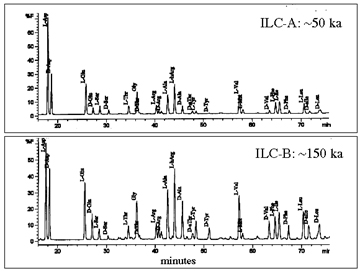
The procedure for reverse phase chromatography used by the
AAGL is described by Kaufman and Manley (1998), and modified for microfossils by Kaufman (2000). The method uses pre-column derivatization with o-phthaldialdehyde (
OPA) together with the chiral thiol, N-isobutyryl-L-cysteine (
IBLC), to yield fluorescent diastereomeric derivatives of chiral primary amino acids. Sample derivatization is performed on-line prior to each injection using an auto-injector. Separation is by C18 stationary phase (Hypersil
BDS, 5 Ám) using a linear gradient of aqueous sodium acetate, methanol, and acetonitrile. Detection is by fluorescence (Ex = 230 nm, Em = 445 nm). The procedure for ion exchange liquid chromatography was originated by Hare et al. (1985). The method uses step-wise addition of sodium-citrate buffers of increasing pH and post-column derivitization by
OPA, with detection by fluorescence. Both methods rely on internal spikes of non-protein amino acids to calibrate the concentration of amino acids in each sample.
References
Hare, P.E., St. John, P.A., and Engel, M.H., 1985, Ion-exchange separation of amino acids, in Garrett, G.C., ed., Chemistry and Biochemistry of the Amino Acids: Chapman and Hall, London, 415-443..
Kaufman, D.S., and Manley, W.F., 1998, A new procedure for determining enantiomeric (D/L) amino acid ratios in fossils using reverse phase liquid chromatography: Quaternary Science Reviews (Quaternary Geochronology) 17, 987-1000.
Kaufman, D.S., 2000, Amino acid racemization in ostracodes, in Goodfriend, G., Collins, M., Fogel, M., Macko, S., and Wehmiller, J., eds., Perspectives in Amino Acid and Protein Geochemistry: Oxford University Press, New York, 145-160.
 The procedure for reverse phase chromatography used by the AAGL is described by Kaufman and Manley (1998), and modified for microfossils by Kaufman (2000). The method uses pre-column derivatization with o-phthaldialdehyde (OPA) together with the chiral thiol, N-isobutyryl-L-cysteine (IBLC), to yield fluorescent diastereomeric derivatives of chiral primary amino acids. Sample derivatization is performed on-line prior to each injection using an auto-injector. Separation is by C18 stationary phase (Hypersil BDS, 5 Ám) using a linear gradient of aqueous sodium acetate, methanol, and acetonitrile. Detection is by fluorescence (Ex = 230 nm, Em = 445 nm). The procedure for ion exchange liquid chromatography was originated by Hare et al. (1985). The method uses step-wise addition of sodium-citrate buffers of increasing pH and post-column derivitization by OPA, with detection by fluorescence. Both methods rely on internal spikes of non-protein amino acids to calibrate the concentration of amino acids in each sample.
The procedure for reverse phase chromatography used by the AAGL is described by Kaufman and Manley (1998), and modified for microfossils by Kaufman (2000). The method uses pre-column derivatization with o-phthaldialdehyde (OPA) together with the chiral thiol, N-isobutyryl-L-cysteine (IBLC), to yield fluorescent diastereomeric derivatives of chiral primary amino acids. Sample derivatization is performed on-line prior to each injection using an auto-injector. Separation is by C18 stationary phase (Hypersil BDS, 5 Ám) using a linear gradient of aqueous sodium acetate, methanol, and acetonitrile. Detection is by fluorescence (Ex = 230 nm, Em = 445 nm). The procedure for ion exchange liquid chromatography was originated by Hare et al. (1985). The method uses step-wise addition of sodium-citrate buffers of increasing pH and post-column derivitization by OPA, with detection by fluorescence. Both methods rely on internal spikes of non-protein amino acids to calibrate the concentration of amino acids in each sample. 
 The procedure for reverse phase chromatography used by the AAGL is described by Kaufman and Manley (1998), and modified for microfossils by Kaufman (2000). The method uses pre-column derivatization with o-phthaldialdehyde (OPA) together with the chiral thiol, N-isobutyryl-L-cysteine (IBLC), to yield fluorescent diastereomeric derivatives of chiral primary amino acids. Sample derivatization is performed on-line prior to each injection using an auto-injector. Separation is by C18 stationary phase (Hypersil BDS, 5 Ám) using a linear gradient of aqueous sodium acetate, methanol, and acetonitrile. Detection is by fluorescence (Ex = 230 nm, Em = 445 nm). The procedure for ion exchange liquid chromatography was originated by Hare et al. (1985). The method uses step-wise addition of sodium-citrate buffers of increasing pH and post-column derivitization by OPA, with detection by fluorescence. Both methods rely on internal spikes of non-protein amino acids to calibrate the concentration of amino acids in each sample.
The procedure for reverse phase chromatography used by the AAGL is described by Kaufman and Manley (1998), and modified for microfossils by Kaufman (2000). The method uses pre-column derivatization with o-phthaldialdehyde (OPA) together with the chiral thiol, N-isobutyryl-L-cysteine (IBLC), to yield fluorescent diastereomeric derivatives of chiral primary amino acids. Sample derivatization is performed on-line prior to each injection using an auto-injector. Separation is by C18 stationary phase (Hypersil BDS, 5 Ám) using a linear gradient of aqueous sodium acetate, methanol, and acetonitrile. Detection is by fluorescence (Ex = 230 nm, Em = 445 nm). The procedure for ion exchange liquid chromatography was originated by Hare et al. (1985). The method uses step-wise addition of sodium-citrate buffers of increasing pH and post-column derivitization by OPA, with detection by fluorescence. Both methods rely on internal spikes of non-protein amino acids to calibrate the concentration of amino acids in each sample.